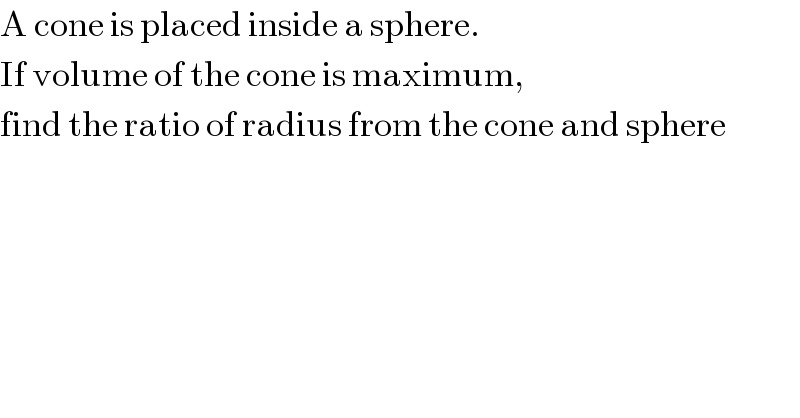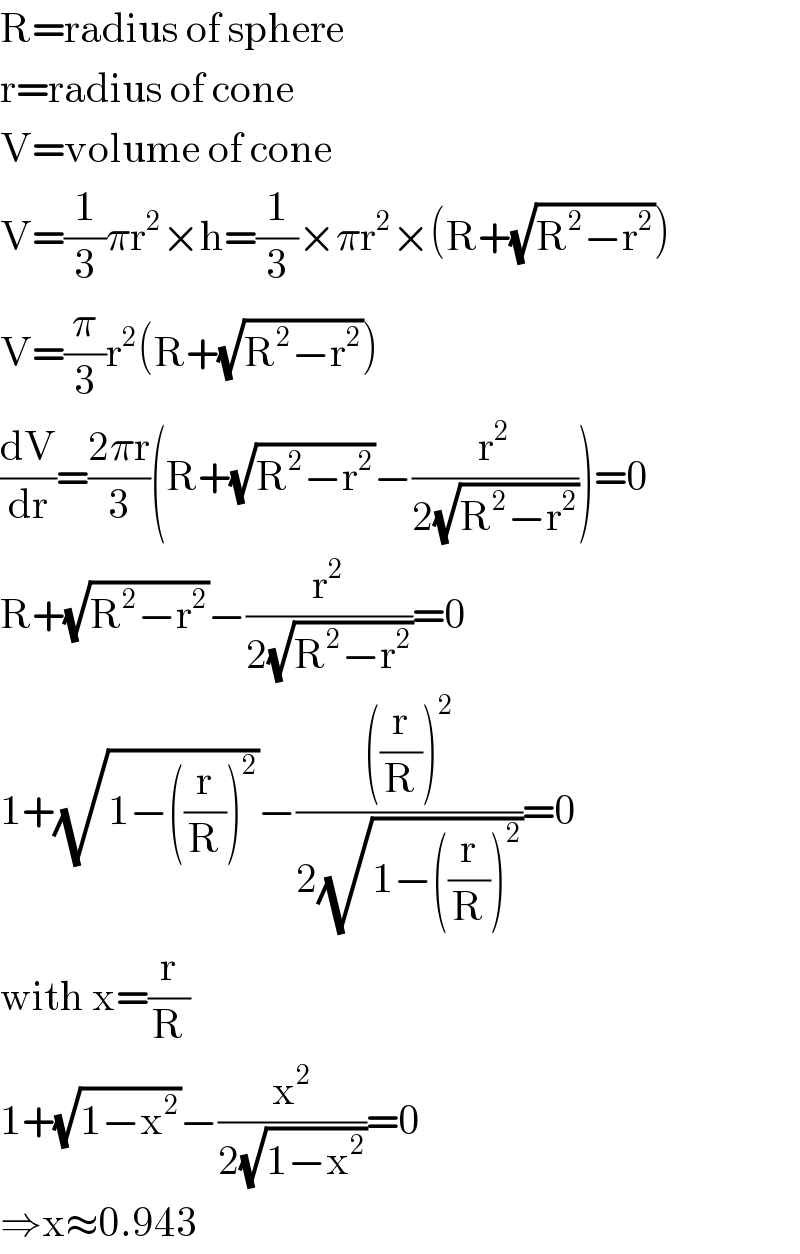
Question Number 21840 by Joel577 last updated on 05/Oct/17

$$\mathrm{A}\:\mathrm{cone}\:\mathrm{is}\:\mathrm{placed}\:\mathrm{inside}\:\mathrm{a}\:\mathrm{sphere}. \\ $$$$\mathrm{If}\:\mathrm{volume}\:\mathrm{of}\:\mathrm{the}\:\mathrm{cone}\:\mathrm{is}\:\mathrm{maximum}, \\ $$$$\mathrm{find}\:\mathrm{the}\:\mathrm{ratio}\:\mathrm{of}\:\mathrm{radius}\:\mathrm{from}\:\mathrm{the}\:\mathrm{cone}\:\mathrm{and}\:\mathrm{sphere} \\ $$
Answered by mrW1 last updated on 05/Oct/17

$$\mathrm{R}=\mathrm{radius}\:\mathrm{of}\:\mathrm{sphere} \\ $$$$\mathrm{r}=\mathrm{radius}\:\mathrm{of}\:\mathrm{cone} \\ $$$$\mathrm{V}=\mathrm{volume}\:\mathrm{of}\:\mathrm{cone} \\ $$$$\mathrm{V}=\frac{\mathrm{1}}{\mathrm{3}}\pi\mathrm{r}^{\mathrm{2}} ×\mathrm{h}=\frac{\mathrm{1}}{\mathrm{3}}×\pi\mathrm{r}^{\mathrm{2}} ×\left(\mathrm{R}+\sqrt{\mathrm{R}^{\mathrm{2}} −\mathrm{r}^{\mathrm{2}} }\right) \\ $$$$\mathrm{V}=\frac{\pi}{\mathrm{3}}\mathrm{r}^{\mathrm{2}} \left(\mathrm{R}+\sqrt{\mathrm{R}^{\mathrm{2}} −\mathrm{r}^{\mathrm{2}} }\right) \\ $$$$\frac{\mathrm{dV}}{\mathrm{dr}}=\frac{\mathrm{2}\pi\mathrm{r}}{\mathrm{3}}\left(\mathrm{R}+\sqrt{\mathrm{R}^{\mathrm{2}} −\mathrm{r}^{\mathrm{2}} }−\frac{\mathrm{r}^{\mathrm{2}} }{\mathrm{2}\sqrt{\mathrm{R}^{\mathrm{2}} −\mathrm{r}^{\mathrm{2}} }}\right)=\mathrm{0} \\ $$$$\mathrm{R}+\sqrt{\mathrm{R}^{\mathrm{2}} −\mathrm{r}^{\mathrm{2}} }−\frac{\mathrm{r}^{\mathrm{2}} }{\mathrm{2}\sqrt{\mathrm{R}^{\mathrm{2}} −\mathrm{r}^{\mathrm{2}} }}=\mathrm{0} \\ $$$$\mathrm{1}+\sqrt{\mathrm{1}−\left(\frac{\mathrm{r}}{\mathrm{R}}\right)^{\mathrm{2}} }−\frac{\left(\frac{\mathrm{r}}{\mathrm{R}}\right)^{\mathrm{2}} }{\mathrm{2}\sqrt{\mathrm{1}−\left(\frac{\mathrm{r}}{\mathrm{R}}\right)^{\mathrm{2}} }}=\mathrm{0} \\ $$$$\mathrm{with}\:\mathrm{x}=\frac{\mathrm{r}}{\mathrm{R}} \\ $$$$\mathrm{1}+\sqrt{\mathrm{1}−\mathrm{x}^{\mathrm{2}} }−\frac{\mathrm{x}^{\mathrm{2}} }{\mathrm{2}\sqrt{\mathrm{1}−\mathrm{x}^{\mathrm{2}} }}=\mathrm{0} \\ $$$$\Rightarrow\mathrm{x}\approx\mathrm{0}.\mathrm{943} \\ $$
Commented by Joel577 last updated on 05/Oct/17

$$\mathrm{I}\:\mathrm{dont}\:\mathrm{understand}\:\mathrm{why}\:{V}\:=\:\mathrm{4}\pi{r}^{\mathrm{2}} \sqrt{{R}^{\mathrm{2}} \:−\:{r}^{\mathrm{2}} } \\ $$$$\mathrm{I}\:\mathrm{think}\:\mathrm{it}\:\mathrm{is}\:{V}\:=\:\frac{\mathrm{1}}{\mathrm{3}}\pi{r}^{\mathrm{2}} {h} \\ $$
Commented by mrW1 last updated on 05/Oct/17

$$\mathrm{you}\:\mathrm{are}\:\mathrm{right}\:\mathrm{sir}. \\ $$$$\mathrm{I}\:\mathrm{have}\:\mathrm{corrected}. \\ $$
Commented by Joel577 last updated on 05/Oct/17

$${thank}\:{you}\:{very}\:{much} \\ $$
